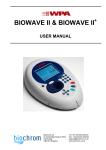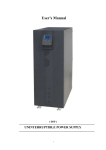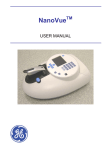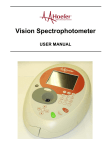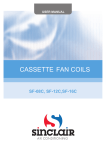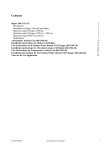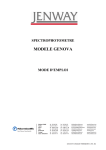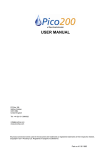Download GeneQuant pro User Manual
Transcript
GeneQuant pro User Manual English Deutsch Français Español Italiano Biochrom Ltd Certificate No. 890333 Declaration of Conformity This is to certify that the GeneQuant pro UV/Vis Spectrophotometer Part number 80-2114-98 / 99 and 80-2115-04 / 05 Serial number 79000 onwards manufactured by Biochrom Ltd. conform to the requirements of the following Directives-: 73/23/EEC & 89/336/EEC Standards to which conformity is declared EN 61 010-1: 2001 Safety requirements for electrical equipment for measurement, control and laboratory use. EN 61326: 1998 Electrical equipment for measurement, control and laboratory use – EMC requirements Dated: 23nd October 2002 Signed: David Parr Managing Director Biochrom Ltd Postal address Telephone Telefax Biochrom Ltd 22 Cambridge Science Park Milton Road Cambridge CB4 0FJ England +44 1223 423723 +44 1223 420164 e mail: [email protected] website: http://www.biochrom.co.uk Registered in England No: 974213 Registered Office: 22 Cambridge Science Park, Milton Road, Cambridge CB4 4FJ, England. ___________________________________________________________________ Issue 06 - 12/2003 GeneQuant pro, English 1 CONTENTS Unpacking, Positioning and Installation Essential Safety Notes Rear panel OPERATION Introduction Instrument Description Utility keys Reading keys 4 5 5 6 6 7 7 8 TECHNIQUES DNA, RNA and oligonucleotide characterisation Nucleic Acid Quantification (NAQ) Nucleic Acid Purity Checks Use of Background Correction Protein Determination Protein Determination at 595, 546 and 562 nm Protein Determination at 280 nm Bacterial Cell Culture Measurement 9 9 9 10 11 12 12 12 13 SET UP AND SAMPLE MEASUREMENT Set up Sample measurement DNA, RNA and oligo Base Sequence Tm Protein 595 Assay Protein 280 Measurement Bacterial Cell Culture 14 14 14 16 18 19 20 22 22 MESSAGES 23 OUTPUT OF RESULTS Use with parallel printer Use with PC 24 24 24 CELLS Selecting the appropriate cell Comparison of instrument with other spectrophotometers Filling cells Taking measurements Cleaning cells Reproducibility using reduced aperture ultramicrovolume and capillary cells 25 25 26 26 26 27 27 ___________________________________________________________________ Issue 06 - 12/2003 GeneQuant pro, English 2 ACCESSORIES 27 MAINTENANCE After Sales Support Performance Verification Check (Cal Check Utility Key) Cleaning and General Care of the Instrument Fuse Replacement Deuterium Lamp Warranty Deuterium Lamp Replacement 28 28 28 29 29 29 30 SPECIFICATION 31 ___________________________________________________________________ Issue 06 - 12/2003 GeneQuant pro, English 3 Unpacking, Positioning and Installation • Inspect the instrument for any signs of damage caused in transit. If any damage is discovered, inform your supplier immediately. • Ensure your proposed installation site conforms to the environmental conditions for safe operation: • • • Indoor use only Temperature 10°C to 40°C Maximum relative humidity of 80 % up to 31°C decreasing linearly to 50 % at 40°C • The instrument must be placed on a hard, flat bench or table that can take its weight (4 kg) such that air is allowed to circulate freely around the instrument. • Ensure that the cooling fan inlets and outlets are not obstructed; position at least 5 cm from the wall. • This equipment must be connected to the power supply with the power cord supplied and MUST BE EARTHED (GROUNDED). It can be used on 100 240V supplies. • Switch on the instrument at the rear panel; the instrument initialises for a few seconds and then goes through a calibration procedure for a minute or so, until the display shows “Instrument Ready” together with information relating to serial number, software version, date and sample number. • If this equipment is used in a manner not specified or in environmental conditions not appropriate for safe operation, the protection provided by the equipment may be impaired and instrument warranty withdrawn. ___________________________________________________________________ Issue 06 - 12/2003 GeneQuant pro, English 4 Essential Safety Notes There are a number of warning labels and symbols on your instrument. These are there to inform you where potential danger exists or particular caution is required. Before commencing installation, please take time to familiarise yourself with these symbols and their meaning. Caution (refer to accompanying documents). Background colour is yellow, symbol and outline are black. Rear panel 1 1. 2. 3. 2 3 Multi purpose interface socket Power supply switch (1 = on, 0 = off) Power supply socket ___________________________________________________________________ Issue 06 - 12/2003 GeneQuant pro, English 5 OPERATION Introduction Your GeneQuant pro RNA/DNA Calculator is a unique, yet simple to use spectrophotometer designed specifically for molecular biologists working in the life sciences, including biotechnology and drug discovery research. It has a pulsed deuterium borosilicate glass lamp for long life. It measures absorbance at 230, 260, 280, 320, 546, 562, 595 and 600 nm, and various relevant parameters are calculated automatically, and displayed at the touch of a button. The instrument is ideal for many routine molecular biologist activities: • it can determine the concentration (in µg/ml, ng/µl, µg/µl, pmol/µl or pmol phosphate) and purity of nucleic acids (DNA, RNA and oligonucleotides) after PCR amplification, for hybridisation studies and for quantitating minipreps. The wavelength at 260 nm is used to calculate quantification, and, together with those at 230 and 280 nm, for purity checking calculations (via 260/230 and 260/280 ratios). The wavelength at 320 nm is used for background compensation. A variety of cells, including UV transparent disposable cells, is now available for convenient sampling, depending on sample concentration, dilution factor and available sample volume. A nucleic acid survey scan facility is available so that the spectrum of samples can be viewed. • it can calculate annealing temperatures for primers prior to PCR upon entry of the oligonucleotide sequence and concentration together with the total buffer molarity; this is done using the nearest neighbour thermodynamic data for each base in the nucleotide chain in relation to its neighbour (Breslauer et al, Proc. Natl, Acad. Sci. USA, 83, 3746, 1986). • it can be used for protein determination using the Bradford, Biuret and BCA protein assays at 595, 546 and 562 nm, respectively; samples are measured against a stored standard curve and the linear regression results of the straight line are printed out. • it can measure OD 600 for bacterial cell culture solutions in order to optimise induction and harvest times. To facilitate electronic project archiving of experimental results, all data can be downloaded directly to Excel using the appropriate interface adapter lead. Results can also be printed to a standard Centronics parallel printer. A calibration check filter set is available for periodic testing of the instrument for GLP purposes (wavelength accuracy, absorbance accuracy and stray light); results of tests and status of instrument can only be viewed by downloading to PC or printing as an aid to record keeping. The user friendly measurement system offers ease of use and ensures a long lamp lifetime, minimising the cost of ownership of the product. ___________________________________________________________________ Issue 06 - 12/2003 GeneQuant pro, English 6 Instrument Description The display is a 128 x 64 pixel back lit graphics liquid crystal and the keypad has 28 keys organised into 3 areas; numeric keypad, utility keys and reading keys, including set up (see inner front cover for diagram). After switch on, initialisation and the calibration process, the instrument is ready for use (“Instrument Ready”). Note the following points • • • it may be necessary to set up the instrument for your measurement, particularly for nucleic acid quantification, where low volume and reduced aperture cells are used, and for doing a Bradford protein determination set reference is always required at the start of each measurement type; insert reference and sample cells so that the light path direction is in the back to front axis of the instrument press the appropriate reading or enter key after the sample has been inserted (length of measurement time is dependent on the number of wavelengths being read, all wavelengths are read in absorbance mode over a period of approx. 12 seconds) Utility keys set up cal check select print base seq. Tm stop set ref enter Enables configuration for the various instrument functions (see Set up). Pressing set up after the appropriate reading key will activate the set up process for that mode, with the first option being highlighted. Enables instrument to be tested for absorbance accuracy, wavelength accuracy and stray light with special filters (see Performance Verification Check) Enables review of options in the set up parameters and viewing results for base sequence and nucleic acid modes (if scan option is on) Outputs data to printer or PC via multi purpose output port Enables entry of a primer or oligonucleotide base sequence for calculation of Theoretical Absorbance, Molecular Weight and conversion factor (see Base Sequence Entry) Enables determination of Tm (from Abs260) and display of calculated Tm for an entered base sequence (see Tm) Behaves as an “escape” key, moving the user back to “Instrument Ready” Reads reference values at appropriate wavelengths Enter / accept option in set up, and acts as reading key ___________________________________________________________________ Issue 06 - 12/2003 GeneQuant pro, English 7 Reading keys abs measures absorbances at calculates measure on DNA measures absorbances at calculates measure on RNA measures absorbances at calculates measure on oligo measures absorbances at calculates measure on 230, 260, 280, 320, 595, 600 nm no results are calculated individual samples 230, 260, 280, 320 nm DNA concentration 260/280 and 260/230 ratio individual samples 230, 260, 280, 320 nm RNA concentration 260/280 and 260/230 ratio individual samples 230, 260, 280, 320 nm oligo / primer concentration 260/280 ratio and 260/230 ratio individual samples protein 595 assay measures absorbances at calculates measure on 595, 546 or 562 nm protein concentration individual samples relative to a calibration curve of known standards protein 280 meas. measures absorbances at 260, 280, 320 nm calculates measure on protein concentration individual samples measures optical density at calculates measure on 600 nm corrected OD individual samples cell culture ___________________________________________________________________ Issue 06 - 12/2003 GeneQuant pro, English 8 TECHNIQUES DNA, RNA and oligonucleotide characterisation Nucleic Acid Quantification (NAQ) • Nucleic acids can be quantified at 260 nm because it is well established that a solution of DNA or RNA with an optical density of 1.0 has a concentration of 50 or 40 µg/ml, respectively, in a 10 mm pathlength cell. Oligonucleotides, as a rule of thumb, have a corresponding factor of 33 µg/ml, although this does vary with base composition; this can be calculated if the base sequence is known (see Base Sequence in Set up and below). Concentration = Abs260 * Factor • The instrument uses factors 50, 40 and 33 as defaults for DNA, RNA and oligonucleotides, respectively, and compensates for dilution and use of cells which do not have 10 mm pathlength; dilution factor and cell pathlength are entered via set up. • If using the ultramicrovolume or capillary reduced aperture cells, ensure they are correctly filled by carefully following the instructions supplied with the cell (see Cells) and that the correct pathlength has been entered. • Default units are µg/ml, but units of ng/µl, µg/µl, pmol/µl and pmol phosphate can be selected via set up (the pmol/µl unit is useful for sequencing and PCR calculations involving primers). The following conversions are used: 1 µg/ml = 1 ng/µl = 0.001 µg/µl pmol/µl = µg/ml x 1000 MW of oligo pmol phosphate = nucleotide concentration, µg/ml 315 • The molecular weight (MW) of a DNA oligonucleotide is calculated from MW (g/mole) = [(dA x 312.2) + (dC x 288.2) + (dG x 328.2) + (dT x 303.2.)] + [(MW counter-ion) x (length of oligo in bases)] (for RNA oligonucleotide, (dT x 303.2) is replaced by (dU x 298.2) The MW calculated using this equation must be adjusted for the contribution of the atoms at the 5’ and 3’ ends of the oligo. Phosphorylated oligos, add: [17 + (2 x MW counter-ion)] Non-phosphorylated oligos, subtract: [61 + (MW counter-ion)] The MW (g/mole) of the most common oligo counter-ions are Na (sodium, 23.0), K (potassium, 39.1) and TEA (Triethylammonium, 102.2). ___________________________________________________________________ Issue 06 - 12/2003 GeneQuant pro, English 9 Nucleic Acid Purity Checks • The extraction of nucleic acids from cells is accompanied by protein, and extensive purification is required to separate the protein impurity. The 260/280 ratio gives an indication of purity; it is only this, however, and not a definitive assessment. Pure DNA and RNA preparations have expected ratios of ≥ 1.8 and ≥ 2.0, respectively; deviations from this indicate the presence of impurity in the sample, but care must be taken in interpretation of results. • The 260 nm reading is taken near the top of a broad peak in the absorbance spectrum for nucleic acids, whereas the 280 nm reading is taken on a steep slope (i.e. small changes in wavelength cause large changes in absorbance). Consequently, small variations in wavelength at 280 nm will have a greater effect on the 260/280 ratio than will variations at 260 nm. Thus different instruments of the same and different types may give slightly different ratios due to variations in wavelength accuracy, but each instrument will give consistent results within itself. • Concentration will also affect 260/280 readings. If a solution is too dilute, the readings will be at the instrument’s detection limit, and results may vary because there is less distinction of the 260 peak and 280 slope from the background absorbance. This is one reason why absorbances should be > 0.05 for accurate measurements. • An elevated absorbance at 230 nm can indicate the presence of impurities as well; 230 nm is near the absorbance maximum of peptide bonds and also indicates buffer contamination since Tris, EDTA and other buffer salts absorb at this wavelength. When measuring RNA samples, the 260/230 ratio should be > 2.0; a ratio lower than this is generally indicative of contamination with guanidinium thiocyanate, a reagent commonly used in RNA purification and which absorbs over the 230 - 260 nm range. The nucleic acid survey scan facility is particularly useful for RNA samples. • The instrument can display 260/280 and 260/230 ratios, and compensates for dilution and use of cells that do not have 10 mm pathlength; dilution factor and cell pathlength are selected via set up. ___________________________________________________________________ Issue 06 - 12/2003 GeneQuant pro, English 10 Use of Background Correction • Background correction at a wavelength totally separate from the nucleic acid and protein peaks at 260 and 280 nm, respectively, is sometimes used to compensate for the effects of background absorbance. The wavelength used is 320 nm and it can allow for the effects of turbidity, high absorbance buffer solution and the use of reduced aperture cells. The instrument can use background correction; its use is selected via set up. • If it is used, different results will be obtained to when it is not used because Abs320 is subtracted from Abs260 and Abs280 prior to use in equations: Concentration = (Abs 260 - Abs 320) * Factor Abs ratio = (Abs 260 - Abs 320) / (Abs 280 - Abs 320) Abs ratio = (Abs 260 - Abs 320) / (Abs 230 - Abs 320) • If your laboratory has not used background correction before, set this option to NO. • The use of background correction can remove variability due to handling effects if the capillary cell or ultramicrovolume cell is being used (see Cells). Spectral scan of nucleic acid (obtained using SWIFT software) Note: • absorbance maximum near 260 nm and absorbance minimum near 230 nm • flat peak near 260 nm and steep slope at 280 nm • very little absorbance at 320 nm ___________________________________________________________________ Issue 06 - 12/2003 GeneQuant pro, English 11 Protein Determination Protein Determination at 595, 546 and 562 nm • • • • The Bradford method depends on quantitating the binding of a dye, Coomassie Brilliant Blue, to an unknown protein and comparing this binding to that of different, known concentrations of a standard protein at 595 nm; this is usually BSA, bovine serum albumin. The Biuret method depends on reaction between Cupric ions and peptide bonds in an alkali solution, resulting in the formation of a complex absorbing at 546 nm. The BCA method also depends on reaction between Cupric ions and peptide bonds, but in addition combines this reaction with the detection of Cuprous ions using bicinchoninic acid (BCA), giving an absorbance maximum at 562 nm. The BCA process is less sensitive to the presence of detergents used to break down cell walls. Detailed protocols are supplied with these assay kits, and must be closely followed to ensure accurate results are obtained. Due to the low lamp energy at 546 - 595 nm, absorbances greater than 2.000 cannot be measured. The use of plastic disposable cells is recommended. To include the zero concentration standard include it in the number of standards to be entered and enter 0.00 for concentration; use this when required to enter standard 1. If using duplicates, enter the same concentration twice; 2 duplicates of 3 different concentration equals 6 standards. Set reference on water. A linear regression analysis of the calibration standard data points is calculated; the result, together with the correlation coefficient, is printed out. A correlation coefficient of between 0.95 and 1.00 indicates a good straight line. Protein Determination at 280 nm • • • Protein can be determined in the near UV at 280 nm due to absorption by tyrosine, tryptophan and phenylalanine amino acids; Abs 280 varies greatly for different proteins due to their amino acid content, and consequently the specific absorption value for a particular protein must be determined. The presence of nucleic acid in the protein solution can have a significant effect due to strong nucleotide absorbance at 280 nm. To compensate for this by measuring Abs 260, the equation of Christian and Warburg for the protein crystalline yeast enolase (Biochemische Zeitung 310, 384 (1941)) can be applied: Protein (mg/ml) = 1.55 * Abs 280 - 0.76 * Abs 260 or, Protein conc. = (Factor 1 * Abs 280) - (Factor 2 * Abs 260) This equation can be applied to other proteins if the corresponding factors are known. The instrument can determine protein concentration at 280 nm and ___________________________________________________________________ Issue 06 - 12/2003 GeneQuant pro, English 12 • • • uses the above equation as default; the factors can be changed, and the use of background correction at 320 nm is optional (via set up). To customise the equation for a particular protein, the absorbances at 260 and 280 nm should be determined at known protein concentrations to generate simple simultaneous equations; solving these provides the two coefficients. In cases where Factor 2 is found to be negative, it should be set to zero since it means there is no contribution to the protein concentration due to absorbance at 260 nm. Set Factor 2 = 0.00 for direct λ280 UV protein measurement; Factor 1 is based on the extinction coefficient of the protein. If BSA (bovine serum albumin) is an acceptable standard, setting Factor 1 = 1.115 will give linear results from 0 to 0.8 mg/ml protein. Protein (mg/ml) = 1.115 * Abs 280 Rapid measurements such as this at Abs 280 are particularly useful after isolation of proteins and peptides from mixtures using spin and HiTrap columns by centrifuge and gravity, respectively. Bacterial Cell Culture Measurement • Bacterial cell cultures are routinely grown to an OD 600 of approx. 0.4 prior to induction or harvesting. A linear relationship exists between cell number (density) and OD 600 up to approx. 0.600 OD. • It is important to note that for turbid samples such as cell cultures, the light intensity measured is the proportion of the scattered light reaching the detector, and not the result of molecular absorption. The amount of scatter is affected by the optics of the system (distance between the cell holder and instrument exit slit, geometry of this slit and the monochromator optics). Different spectrophotometer types therefore give different responses for the same turbid sample; to compare results, they must be normalised using calibration curves. • A calibration curve can be determined by comparing measured OD to expected OD. Expected OD is determined by counting cell number using an alternative technique (for example microscope slide method) and converting to OD using the rule of thumb that 1 OD 600 = 8 x 108 cells/ml for E. Coli. • GeneQuant pro has much smaller optics than most conventional spectrophotometers, and more scattered light is transmitted through to the detector resulting in lower than expected OD 600 values. Results obtained by comparing measured OD 600 with expected OD 600 (see above) indicate that a correction factor of 2.0 is required to make the data comparable to larger instruments; this factor is included as a default value in set up. • The use of 10mm pathlength disposable cells is recommended for optical density measurements of cell culture solutions; to prevent the suspension settling too quickly and giving an OD that changes with time, glycerol should be added to the sample. ___________________________________________________________________ Issue 06 - 12/2003 GeneQuant pro, English 13 SET UP AND SAMPLE MEASUREMENT Set up • • • For instrument set up, press “set up”. Press the appropriate “reading key” followed by the “set up” key to access relevant options (there is no set up for absorbance). Press “select” and “enter” to work through the various options. Press "stop” at any time to return to Instrument Ready status or to go back a level. Day Month Year Sample No. Key in date (adjust daily) Select appropriate month Key in year. Key in required number (increments automatically, default is 1) Output Mode Survey Scan Language Select output to Printer (standard Centronics parallel lead required), Serial (a special serial lead is required for connection to PC) or None Automatic output of reading key results to Printer or PC; print key is disabled. Select On or Off Select On, Off or Print; relevant to Nucleic Acid modes only Select English, German, French, Spanish or Italian Use Date Key Click Select On or Off; off means that date will not be printed Select On or Off AutoPrint Sample measurement • • • • Press “reading” key to access the mode, then “set ref” key to set reference • Measurements are taken at all relevant wavelengths, and displayed as 0.000 values. A “Starting Lamp” message is displayed prior to measurement. Press “reading” key again, or “enter”, in order to make readings. • Measurements are taken at all relevant wavelengths, and actual absorbance values are displayed together with the results of calculations. A “Starting Lamp” message is displayed prior to measurement. Sample number is always displayed; reset using set up. After measurement, press “print” to obtain a print out comprising header, selected set up options, absorbance readings (as appropriate) and the various calculated results (as appropriate). ___________________________________________________________________ Issue 06 - 12/2003 GeneQuant pro, English 14 • If Autoprint is on, results for reading keys only will be output automatically; use of the print key is disabled. ___________________________________________________________________ Issue 06 - 12/2003 GeneQuant pro, English 15 DNA, RNA and oligo Refer to Techniques for further information. Pathlength Units Use 320nm Dilution Factor Insert sample oligo only Default Factor Calc Factor Use Default Insert sample Select 10, 5, 2, 1 or 0.5mm Select required concentration units from µg/ml, ng/µl, µg/µ, pmol/µl, pmol phosphate. pmol/µl is only valid for oligonucleotides, and requires base sequence entry in order to be calculated Select yes or no Key in the dilution factor for the concentration calculation, range 1 1000 Insert reference and press “set ref” Insert sample and press enter or “DNA”/“RNA” as appropriate. The absorbances are measured and displayed together with the 260/230 and 260/280 ratios and the concentration If the sample is too dilute to give reproducible results, the concentration is displayed as “invalid” Press “stop” to exit Default factor of 33 µg/ml. This can be changed, for example to 37 for ssDNA, if required Display shows the conversion factor (µg/ml) if base sequence has been entered Select no if calculated factor is to be used; if yes, default factor is used Insert reference and press “set ref” Insert sample and press enter or “oligo” The absorbances are measured and displayed together with the 260/230 and 260/280 ratios and the concentration Press “stop” to exit Survey Scan On • Survey scan is over the range 220 – 330 nm, and takes about 10 seconds. • • • Lines on the graph indicate 230, 260, 280 and 320 nm. After the scan is complete, results are displayed; use “select” to view the graph. Press “set up” to change absorbance scaling of graph (use “select” and “enter” to choose between 0.1, 0.2, 0.5, 1.0, 2.0, 2.5 and Autoscale). ___________________________________________________________________ Issue 06 - 12/2003 GeneQuant pro, English 16 Examples of output: DNA determination Date: 22 May 2000 Name: …………………… Factor : Units : Pathlength : Dilution Factor : Use 320 nm : 50.0 µg/ml 10mm 1 No No. 230nm 260nm 280nm 320nm 260/280 260/230 Conc. 1 0.230 0.471 0.255 ----1.850 2.045 23.5 Oligonucleotide determination Date: 22 May 2000 Name: …………………… Dflt Factor Units Pathlength Dilution Use 320 nm : : : : : 33.0 µg/ml 10mm 1 No No. 230nm 260nm 280nm 320nm 260/280 260/230 Conc. 1 0.168- 0.325 0.183 ----1.780 1.934 10.7 ___________________________________________________________________ Issue 06 - 12/2003 GeneQuant pro, English 17 Base Sequence Refer to Techniques for further information. Base Type Phosphorylated? Counter Ion Select DNA or RNA Select Yes or No Select Na (sodium), K (potassium), TEA (triethylammonium) or other counter ion Enter Molecular Weight of the counter ion being used Press “enter” to initiate base sequence entry facility for oligonucleotide or primer; press A, C, G, T/U keys as appropriate; minimum 10, maximum 64 mer. Press the “delete” to remove the last base entered, and “cancel” to remove a base sequence (press “select” to change from yes or no). Press “select” to display the parameters calculated from the base sequence calculations: Display shows theoretical absorbance (in units of AU/µmole) Display shows molecular weight of entered base sequence and counter ions, including corrections for phosphorylation; this value is used in the calculation of concentration in pmol/µl and the conversion factor Display shows the conversion factor (µg/ml) of entered base sequence; calculated from MW divided by Theor Abs Other Theor Abs Calc MW Calc Factor Example of output: base sequence Date: 22 May 2000 Name:……………….. AGC,AGC,AGC,AGC,AGC Base type : DNA Phosphorylated? : Yes Counter Ion : Na Theor Abs : 149.1 Calc MW : 5051 Calc Factor : 33.9 ___________________________________________________________________ Issue 06 - 12/2003 GeneQuant pro, English 18 Tm Refer to Techniques for further information; a minimum base sequence of 10 mer needs to have been entered. Primer Conc. Buffer Molarity Calculated Tm Insert sample Key in concentration of primer, range 1.0 – 100.0 pmol/µl Key in molarity of salts in hybridisation solution, range 0.1 10.0 Display shows Tm calculated using the nearest neighbour method applied to the entered base sequence and the primer concentration and the salts molarity entered above. Insert reference and press “set ref” Insert sample and press enter or “Tm The melting temperature based upon the oligonucleotide concentration actually measured in the sample is displayed; this is done by applying the nearest neighbour method to the entered base sequence, and uses the salts molarity entered above. Press “stop” to exit Example of output: Tm Date: 22 May 2000 Name:……………….. Base Sequence AGC,AGC,AGC,AGC,AGC Phosphorylated : Yes Counter Ion : Na Buffer Molarity : 0.100 Primer Conc. : 1.000 Calculated Tm : 57.0 degC No. 1 260nm 0.123 Measured Tm 57.8 ___________________________________________________________________ Issue 06 - 12/2003 GeneQuant pro, English 19 Protein 595 Assay Refer to Techniques for further information. Method No of standards Pathlength Units New standards Standard 1 Standard 2 Insert sample Select Bradford, Biuret or BCA The selected method becomes the default. Key in the number of standards, range 3 - 27 Select 10, 5, 2, 1 or 0.5 mm Select µg/ml, mg/ml, µg Select Yes or No (appears only if no method has been entered) If No, last standards entered are used. If Yes, insert reference and press “set ref” Key in the concentration of the first standard, range 0.0 – 1000.0 Insert Standard 1 and press “enter” The absorbance is measured and displayed together with the concentration of the standard. Press “enter”. Key in the concentration of the next standard, range 0.0 – 1000.0 Insert Standard 2 and press “enter” The absorbance is measured and displayed together with the concentration of the standard. Press “enter”. Repeat procedure until all standards have been measured The standard curve details (slope, correlation coefficient and intercept) are displayed Insert reference and press “set ref” Insert sample and press “enter”. The absorbance is measured and displayed together with the concentration of the sample relative to the standard curve. Repeat procedure until all samples have been measured Press “stop” to exit ___________________________________________________________________ Issue 06 - 12/2003 GeneQuant pro, English 20 Example of output: protein 595 Date: 22 May 2000 Name: ………………. Method : No. of standards 6 No. Abs. 1 0.693 2 0.842 3 0.934 4 1.026 5 1.150 6 1.285 Conc. 0.139 0.278 0.417 0.556 0.650 0.834 Slope Corr Coeff Intercept : : : 0.746 0.996 0.593 Abs. 0.995 Conc. 0.520 0.162 No. 1 2 Bradford ___________________________________________________________________ Issue 06 - 12/2003 GeneQuant pro, English 21 Protein 280 Measurement Refer to Techniques for further information. Coeff. 1 Key in the factor to be used for 280nm; default is 1.550, range is 0.01 - 10.00 Key in the factor to be used for 260nm; default is 0.760, range is 0.00 - 10.00 Select yes or no Insert reference and press “set ref” Insert sample and press enter or “protein 280 The absorbances are measured and displayed together with the calculated concentration Press “stop” to exit Coeff. 2 Use 320nm Insert sample Example of output: Protein 280nm Measurement Date: 22 May 2000 Name:…………….. Coeff 1 Coeff 2 Use 320 nm No. 1 : : : 1.115 0.000 No 260nm 280mn 320nm Conc 0.123 0.275 ----0.307 Bacterial Cell Culture Refer to Techniques for further information. Factor Insert sample Key in the correction factor you have derived from calibration plot to make results directly comparable with other spectrophotometers used in your lab; default is 2.0, and is typical Insert reference and press “set ref” Insert sample and press enter or “cell culture”. The OD at 600 nm is measured and displayed together with the corrected result Press “stop” to exit ___________________________________________________________________ Issue 06 - 12/2003 GeneQuant pro, English 22 MESSAGES The following messages may appear during use of the instrument: > 2.000 Invalid Curve Protein 595 and Cell Culture readings only valid up to 2.000 A Standards have not been inserted in corrected order or absorbance values do not increase sequentially Solution too dilute For reproducible results, a more concentrated sample or a longer pathlength cell should be used Too much light Sample compartment lid not closed properly Ref 1 error Check sample compartment area for blockage Ref 2 error Check sample compartment area for blockage Lamp failure Lamp failed to strike; switch off and try again. Lamp may need replacing if symptom persists Contact your supplier if the messages below, or any other obvious fault messages appear, and cannot be cleared by re-initialising the instrument: Lamp too hot Filter error Grating error Fan has failed or air grill is blocked Filter wheel has not aligned properly Grating has not aligned properly ___________________________________________________________________ Issue 06 - 12/2003 GeneQuant pro, English 23 OUTPUT OF RESULTS Use with parallel printer • • • We recommend the use of the Seiko DPU-414 thermal printer, however, any Centronics parallel printer can be used together with the appropriate cable. If using a thermal printer, ensure it is set up to print out in condensed printing mode (80 characters) so that there is no wrap round (refer to printer user manual; for the Seiko DPU-414, this is in the DIP SW settings section). Ensure output to printer is on in the Set-up. Output is alphanumeric only and automatic when the Print key is pressed, and a printer is connected and switched on. Umlauts and accents are not printed out with letters if the instrument is set up to be in German, French, Italian or Spanish. The Survey Scan can be printed using the Seiko DPU-414 printer only; ensure “Survey Scan” in set up is set to Print, as On enables the facility on the instrument display only. Use with PC NOTE: A standard serial interface will not work. 1) Download to Spreadsheet The serial interface adapter lead (80-2109-02) is required; it is also supplied with the Spreadsheet Interface Software for direct download to Excel. This macro is supplied on a floppy disc together with instructions for installation and use. 2) Use with Hyperterminal The serial interface adapter lead (80-2109-02) is required; ensure output to serial is on in Set-up. The ASCII stream is output at 19,200 Baud via the 25 way D connector on the rear panel, and can be picked up by a PC with Windows 3.1 installed. Use the Hyperterminal emulator in Accessories to pick this up (settings are Handshake None, 19,200 Baud, 1 stop bit, 8 data bits, 0 parity, Comm port depends on which port the lead is connected to). Output is automatic if the interface lead is connected to the instrument. ___________________________________________________________________ Issue 06 - 12/2003 GeneQuant pro, English 24 CELLS Selecting the appropriate cell The instrument measures absorbance in the range 0.005 to 3.000 using a 10 mm pathlength cell; in general, spectrophotometers are at their most accurate in the absorbance range 0.100 to 1.000. The cell should be chosen based on sample concentration, dilution factor and available sample volume. Readings < 0.05 approach the detection level of the instrument, which decreases reproducibility; ideally, such levels should be avoided. Use the table below as a guide to selecting the correct cell. GeneQuant pro has the standard optical height of 15 mm; cells of 8.5 mm optical height require the use of an adapter. Concentration range after dilution (ng/µl) * 5 - 125 10 - 250 100 - 2500 *** * ** *** • • • Available sample volume (µl) > 2000 > 500 > 70 µl > 7 µl > 3 µl Suggested cell type Pathlength (mm) Part number standard semi-micro microvolume ultra microvolume** capillary spare capillaries (100) 10 10 10 5 0.5 80-2002-58 80-2002-77 80-2103-69 80-2103-68 80-2104-66 80-2104-67 assuming dsDNA with Abs 260 = 1.0 for 50 µg/ml (= ng/µl) in a 10 mm pathlength cell this is supplied with a micro sample viewer accessory note that dilution may not be required for a miniprep / PCR amplification where typical concentrations are between 50 and 200 ng/µl The 7 µl ultramicrovolume cell has a minimum detection limit of 2 µg/ml dsDNA assuming an absorbance of 0.020; this equates to 14 ng dsDNA if 7 µl of solution is used. This very low level is not sufficient for reproducible results. Use of background correction is recommended. The capillary cell has a minimum detection limit of 20 µg/ml dsDNA assuming an absorbance of 0.020; this equates to 60ng dsDNA if 3 µl of solution is used. This very low level is not sufficient for reproducible results. Use of background correction is recommended. The use of standard 1 mm and 5 mm pathlength cells is not recommended due to the requirement of a packing piece (not required for the ultra microvolume and capillary cell described above). ___________________________________________________________________ Issue 06 - 12/2003 GeneQuant pro, English 25 Comparison of instrument with other spectrophotometers • • You must compare like with like, using the same sample with the same cell, and obtain absorbance measurements on both at the same wavelengths. GeneQuant pro has a bandwidth of 5 nm, and this should be compared with a spectrophotometer having the same bandwidth, since this parameter affects absorbance values. Filling cells Ensure cells are always clean and dry before use and between samples Standard 10 mm pathlength cells • fill so that the level of the liquid measures at least 20 mm from the cell bottom Microvolume cell (80-2103-69) • fill so that the liquid meniscus cannot intercept the light beam - we recommend at least 70 µl is used Ultramicrovolume cell (80-2103-68) • fill so that the liquid meniscus cannot intercept the light beam - we recommend at least 7 -10 µl is introduced into the pipette fitted with an appropriate tip • insert tip into one of the conical openings of the cell and ensure the tip is pushed in firmly - deliver the sample slowly into the cell while tilting it with the other conical opening upwards to ensure all air is expelled • place cell in micro sample viewer and hold up to the light; when viewed through the eye piece, the 3 X magnification lens enables confirmation that there are no bubbles or other impediments in the light path • ensure the faces of the cell are wiped clean Capillary cell (80-2104-66) and capillaries (80-2104-67) • dipping the capillary into the solution will normally introduce enough liquid for measurement • liquid can be prevented from leaking out using the Cristaseal supplied Taking measurements • Ensure cell pathlength is set to 10 mm (or 5mm for the ultramicrovolume cell, 80-2103-68); ensure cell orientation is always the same For capillary cells: • Ensure cell pathlength is set to 0.5 mm • Place capillary cell holder in sample compartment • Insert capillary ___________________________________________________________________ Issue 06 - 12/2003 GeneQuant pro, English 26 Cleaning cells • • After use, cells should be cleaned with a dilute alkali (e.g. 0.1 M NaOH) and a dilute acid (e.g. 0.1 M HCl) wash, followed by rinsing several times with distilled water. More rigorous cleaning after difficult samples should be performed with a suitable liquid laboratory glassware detergent (e.g. Decon), following the manufacturer’s instructions. The capillary cell can be dismantled for cleaning and removing a broken capillary by unscrewing the two screws on each side using the tool provided. Reproducibility using reduced aperture ultramicrovolume and capillary cells • • • • • Check for correct operation range and sample integrity by inspection of all 4 wavelength readings for nucleic acid measurements Ensure that set reference is renewed periodically (preferably every 10 consecutive readings) Ensure background correction at 320 nm is on Ensure sample dilution is such that sample Abs 260 is greater than 0.100 Ensure cell is scrupulously clean ACCESSORIES Deuterium Lamp Printer Stand Seiko DPU-414 printer Parallel interface cable (Centronics) Interface adapter for serial connection (includes spreadsheet interface software) Spare GeneQuant pro User Manual (multi language) GeneQuant calibration check filter set Spare dust cover Basic UV/Visible Spectrophotometry Booklet 80-2109-86 80-2109-96 enquire 80-2071-87 80-2109-02 80-2110-89 80-2109-88 80-2109-13 80-2108-63 ___________________________________________________________________ Issue 06 - 12/2003 GeneQuant pro, English 27 MAINTENANCE After Sales Support We supply support agreements that help you to fulfil the demands of regulatory guidelines concerning GLP/GMT: • Calibration, certification using filters traceable to international standards • Certificated engineers and calibrated test equipment • Approved to ISO 9001 standard Choice of agreement apart from break down coverage can include: • Preventative maintenance • Certification Performance Verification Check (Cal Check Utility Key) • • • • Verification of instrument performance is important for Good Laboratory Practise (GLP) purposes. GLP requires that results obtained in an experiment can be traced back to an instrument, and that the instrument can be proved to be working correctly. Using a calibration check filter set, the instrument can be checked for absorbance accuracy at 230, 260, 280, 320, 595 and 600nm, wavelength accuracy at 260 and 280nm and stray light at 260nm. An accredited service engineer with your supplier should have a set of filters (secondary standards traceable to NIST), and be able to verify the instrument performance; a certificate for record keeping will be provided. A calibration check filter set (part number 80-2109-88) is available for periodic testing of the instrument to ensure that it is working to specification if you prefer to do it in house; instructions for carrying this out are provided with the filters. Observe all necessary precautions if dealing with hazardous samples or solvents. ___________________________________________________________________ Issue 06 - 12/2003 GeneQuant pro, English 28 Cleaning and General Care of the Instrument External cleaning • Switch off the instrument and disconnect the power cord. • Use a soft damp cloth to clean all external surfaces. • A mild liquid detergent may be used to remove stubborn marks. Sample compartment area spillage • Switch off the instrument and disconnect the power cord. • The sample area is manufactured from a chemical resistant material. Strong concentrations of sample, however, may affect the surface and spillages should be dealt with immediately. • A small drain hole in the sample area allows excess liquid to drain away onto the bench or table from under the instrument. • Use a soft dry cloth to mop out the sample area. • Reconnect the power supply cord and switch on the instrument. Fuse Replacement • • • • • Switch off the instrument and disconnect the power supply cord. The fuse holder can only be opened if the power supply plug has been removed, and is located between the power input socket and the on/off switch on the back panel of the instrument; do not touch the power supply socket prongs. Slide the fuse holder open by pulling at the notch. Place fuses (1.6AT, 5mm x 20mm, FST) into the fuse holder and slide back into position. Reconnect the power supply cord and switch on the instrument. Fuses are not normally consumed in an instrument’s lifetime. If they blow repeatedly, contact your supplier. Deuterium Lamp Warranty The criterion for lamp replacement under warranty is that it must be less than 36 months old. ___________________________________________________________________ Issue 06 - 12/2003 GeneQuant pro, English 29 Deuterium Lamp Replacement Replacement lamps are available from your supplier using the part number 80-2109-86, deuterium lamp assembly. The design of the lamp area is such that users are able to change their own lamps. No lamp alignment is required as the lamps are pre-aligned at manufacture. The lamp becomes very hot in use. Ensure it is cool before changing it. Do not touch the optical surface of the lamp with your fingers (use tissue); if touched, the area should be cleaned with iso-propanol. To replace a lamp proceed as follows: 1) 2) 3) 4) 5) 6) 7) 8) Switch off the instrument and disconnect the power supply cord. Release the instrument cover by unscrewing the seven screws in the base. Carefully lift top cover upwards, tilt and place on the right side of the instrument taking care not to damage the ribbon cables and not to touch any of the circuitry (in particular the heat sink). Depress catch “A” and lift connector away from circuit board. Remove two screws “B”. Lift deuterium lamp and bracket assembly away from mounting plate. Place new deuterium lamp assembly into position, locating pins “C” into holes and slot in mounting plate. Refit two screws “B” and tighten carefully. Refit connector “A”, pushing downwards until the catch snaps shut. Refit the instrument top cover, taking care not to trap the ribbon cable. Refit the seven screws in the base. Reconnect the power supply cord and switch the instrument on. ___________________________________________________________________ Issue 06 - 12/2003 GeneQuant pro, English 30 SPECIFICATION Wavelength range Monochromator Wavelength calibration Spectral bandwidth Wavelength accuracy Wavelength reproducibility Light source Detector Photometric range Photometric linearity Photometric reproducibility Stray Light Digital output Dimensions Weight Power requirements Safety standard EMC emissions EMC immunity Susceptibility standard Quality System Fixed at 230, 260, 280, 320, 546, 562, 595, 600 nm Survey scan from 220 – 330 nm Czerny-Turner configuration with 1200 lines/mm holographic grating Automatic upon switch on 5 nm ± 1 nm Better than ± 0.5 nm Long life borosilicate glass pulsed deuterium lamp Silicon photodiode 0 to ± 3.000A for 230, 260, 280, 320 nm 0 to ± 2.000A for 546, 562, 595, 600 nm ± 1.0% or ± 0.005A to 3.000A, whichever is the greater 0.5% of absorbance value <0.1%T at 280nm using Acetone Centronics parallel as standard 9 pin serial via interface adapter lead 320 x 400 x 160 mm 4 kg 100-240V AC ± 10%, 50/60Hz, 80VA EN61010-1 EN 50 081-1 Generic emissions part 1 EN 50 082-1 Generic immunity part 1 IEC 801 Designed and manufactured in accordance with an ISO 9001 approved quality system Specifications are measured at a constant ambient temperature and are typical of a production unit. As part of our policy of continuous development, we reserve the right to alter specifications without notice. ___________________________________________________________________ Issue 06 - 12/2003 GeneQuant pro, English 31

































